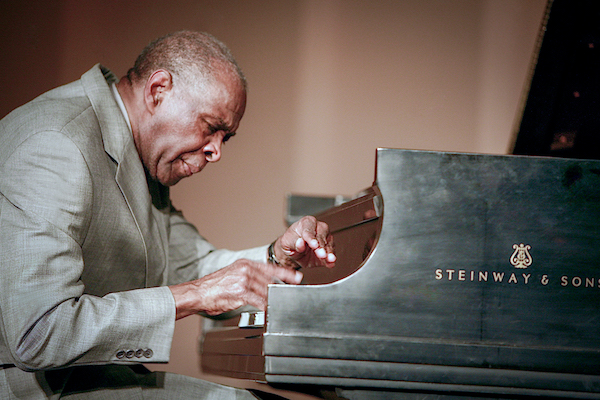Apr 2, 2024 12:59 PM
Saxophonist, Sonic Explorer Casey Benjamin Dies at 45
Casey Benjamin, the alto saxophonist, vocalist, keyboardist and producer who stamped his distinctive sounds on the…

Muhal Richard Abrams (1930–2017)
(Photo: Michael Jackson)Pianist Muhal Richard Abrams—an NEA Jazz Master, inductee in the DownBeat Hall of Fame and one of the founders of the Association for the Advancement of Creative Musicians (AACM)—died at his home in New York City on Oct. 29. He was 87.
In honor of Abrams, below we have posted Ted Panken’s article “The Individual Principle,” which was published in the August 2010 issue of DownBeat.
The Individual Principle
“Interesting,” Muhal Richard Abrams said over the phone upon receiving the news of his election into the DownBeat Hall of Fame. After a pause, he said it again.
Arrangements were made to speak the following day, and, in conversation at the midtown Manhattan high-rise where he has lived since 1977, Abrams explained his laconic response to the honor, bestowed on the heels of his selection as a 2010 NEA Jazz Master.
“Well, why me?” he said. “There are so many worthy people. The only claim I make is that I am a pianist-composer.” He added: “I’m honored that people would want to honor me, and I have no objection, because people have a right to make the decisions they arrive at.”
It was noted that Abrams had communicated precisely the latter dictum 45 years ago at a series of meetings on Chicago’s South Side where the bylaws and aesthetic guideposts by which the Association for the Advancement of Creative Musicians (AACM) continues to operate were debated and established.
“Oh, in terms of individuals being free to be individuals, of course,” Abrams said. “It is a basic principle of human respect.”
Informed of Abrams’ reaction, George Lewis, the Case Professor of Music at Columbia University, who painstakingly traced the contents of these gatherings in A Power Stronger Than Itself: The AACM and American Experimental Music (University of Chicago Press), hollered a deep laugh. “‘Why me?’ Are you kidding?” Assured of the quote’s accuracy, Lewis, an AACM member since 1971, settled down. “That’s Muhal for you,” he said. “He’s not an ego guy. Originally, the book was supposed to be about him. He said, ‘I think it should be about the entire AACM.’”
Lewis then opined on his mentor’s “Why me?” query. “Muhal transcends genres, categories and the little dustups that often happen in the jazz world,” he said. “He’s his own person. He spent his life reaching out to many musical constituencies. So it makes a lot of sense to have him represent a new way of thinking about the whole idea of jazz. Muhal’s major lesson was that you’d better find your own path, and then, once you do, learn to be part of a group of people that exchange knowledge amongst each other. He provides support for an autodidact way of doing things.”
“I don’t characterize myself as a teacher,” Abrams remarked. “It’s my contention that one teaches oneself. Of course, you pick up information from people whose paths you cross. But I’m mainly self-taught—I found it more satisfying to do it that way.”
It is one of Abrams’ signal accomplishments to have been the prime mover in spawning a collaborative infrastructure within which such AACM-trained composer-instrumentalists as Lewis, Roscoe Mitchell, Joseph Jarman, Anthony Braxton, Henry Threadgill, Leo Smith, Amina Claudine Myers and himself could conceptualize and develop ideas. Another is his own singular corpus, as documented on some 30 recordings that present a world in which blues forms, post-bop themes with jagged intervals and experimental pieces in which improvising ensembles address text, sound and space coexist in the same breath with through-scored symphonic works, solo piano music, string, saxophone and brass quartets, and electronic music.
His arsenal also includes formidable pianistic skills, heard recently on “Dramaturns,” an improvised, transidiomatic duo with Lewis on Streaming (Pi)—it’s one of five performances on which Abrams, Lewis and Mitchell, grouped in duo and trio configurations, draw upon an enormous lexicon of sounds while navigating the open spaces from various angles.
“It’s a vintage collaboration,” Abrams said of the project. “Our collaborations date back to Chicago, and the respect that transpires between us on the stage, the respect for the improvised space that we use, is special. Of course, they’re virtuoso musicians, but I’m talking about silence and activity, when to play and when not to play, just from instinct and feeling and respect.”

Benjamin possessed a fluid, round sound on the alto saxophone, and he was often most recognizable by the layers of electronic effects that he put onto the instrument.
Apr 2, 2024 12:59 PM
Casey Benjamin, the alto saxophonist, vocalist, keyboardist and producer who stamped his distinctive sounds on the…

“He’s constructing intelligent musical sentences that connect seamlessly, which is the most important part of linear playing,” Charles McPherson said of alto saxophonist Sonny Red.
Feb 27, 2024 1:40 PM
“I might not have felt this way 30 to 40 years ago, but I’ve reached a point where I can hear value in what people…

Albert “Tootie” Heath (1935–2024) followed in the tradition of drummer Kenny Clarke, his idol.
Apr 5, 2024 10:28 AM
Albert “Tootie” Heath, a drummer of impeccable taste and time who was the youngest of three jazz-legend brothers…

“Both of us are quite grounded in the craft, the tradition and the harmonic sense,” Rosenwinkel said of his experience playing with Allen. “Yet I felt we shared something mystical as well.”
Mar 12, 2024 11:42 AM
“There are a few musicians you hear where, as somebody once said, the molecules in the room change. Geri was one of…

Larry Goldings’ versatility keeps him in high demand as a leader, collaborator and sideman.
Feb 21, 2024 10:45 AM
Are you having any fun? Larry Goldings certainly is. Consider just two recent examples:
Scene 1: “If anyone had…